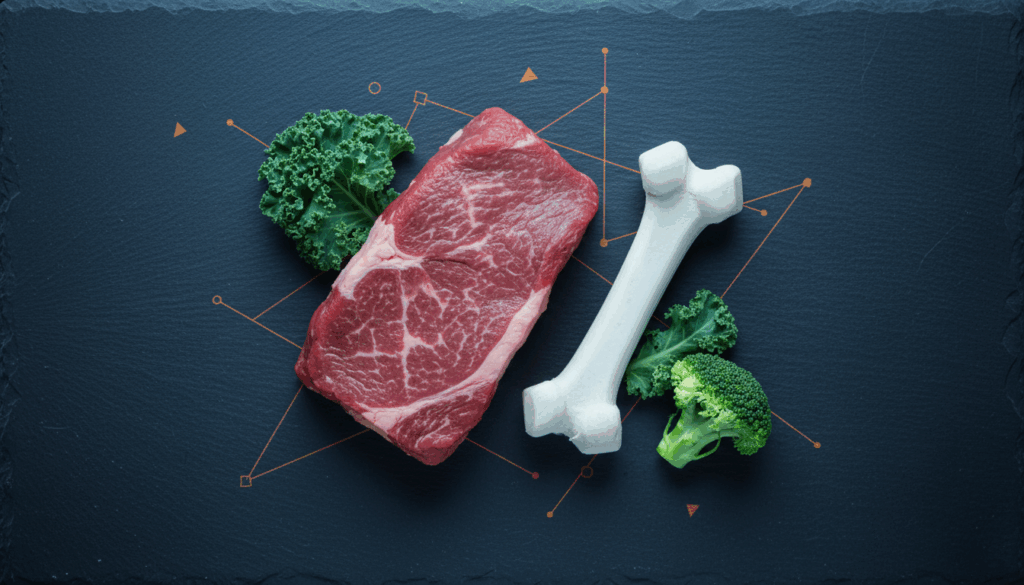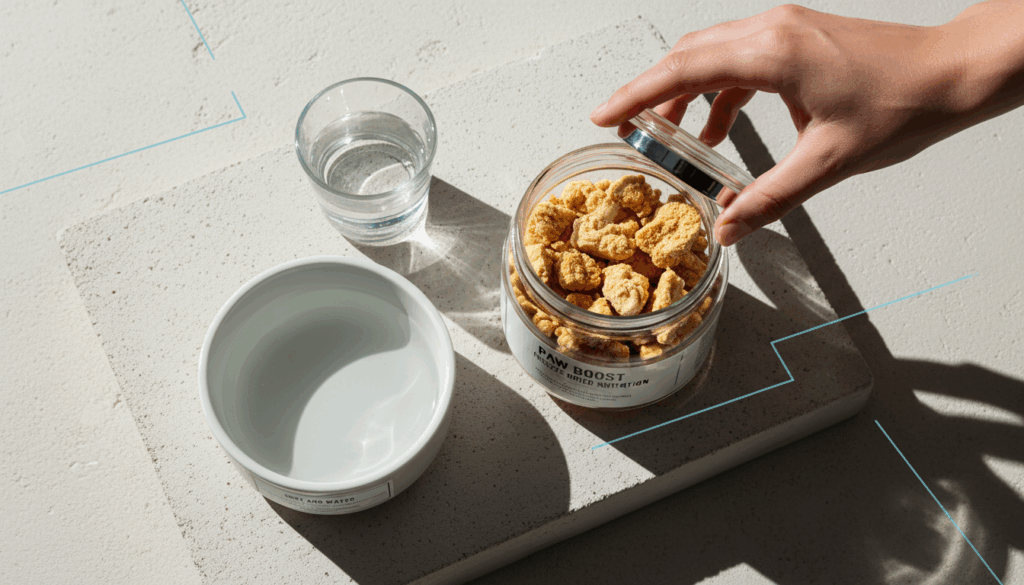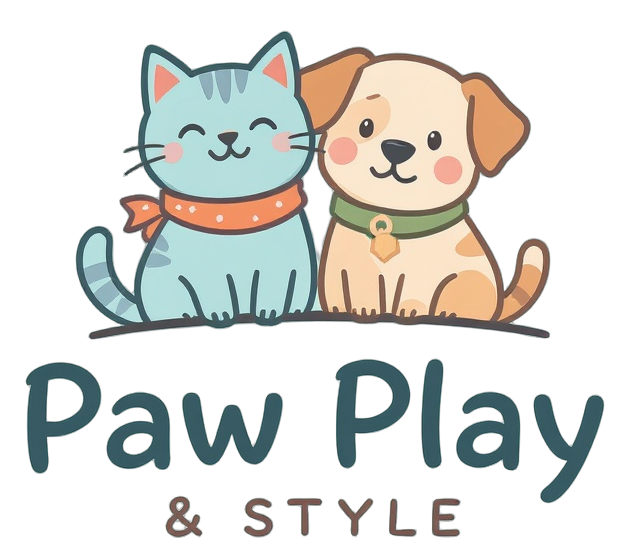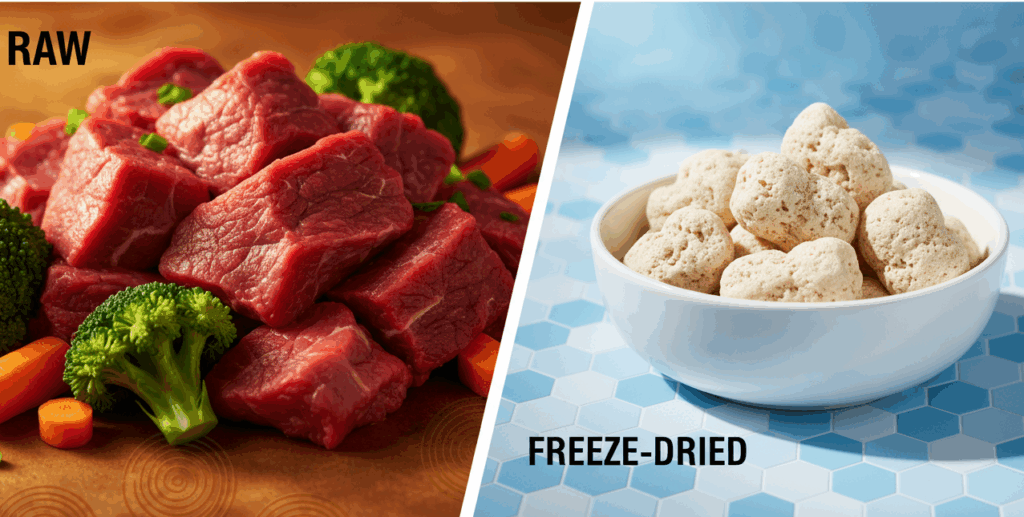As pet owners become more focused on nutrition, health, and convenience, two types of diets have surged in popularity: raw and freeze-dried pet foods. Both promise high-quality protein, minimal processing, and superior nutrition compared to traditional kibble. But which one is the better option for your dog or cat?
This guide breaks down the differences, benefits, drawbacks, and top products of both diets, so you can make an informed choice for your furry friend.
What Is Raw Pet Food?

Raw pet food is made from uncooked animal proteins, organs, and sometimes vegetables, designed to mimic the natural diet of wild dogs and cats.
Benefits of Raw Food:
High in protein and natural nutrients.
Often free from fillers, preservatives, and artificial additives.
Supports muscle development, coat health, and energy levels.
Drawbacks:
Requires strict hygiene and proper storage to avoid bacterial contamination.
Preparation can be time-consuming, especially for homemade raw diets.
May be more expensive than kibble or freeze-dried options.
You Can Buy This: Stella & Chewy’s, Primal Pet Foods, Nature’s Variety Instinct Raw – Ideal for linking
What Is Freeze-Dried Pet Food?

Freeze-dried pet food takes raw ingredients and removes moisture while retaining most of their nutritional value, creating a shelf-stable product that’s convenient to store and serve.
Benefits of Freeze-Dried Food:
Long shelf life without refrigeration.
Maintains most of the nutritional integrity of raw foods.
Easy to feed — just rehydrate or serve dry.
Lower risk of bacterial contamination than traditional raw diets.
Drawbacks:
Can be more expensive per meal than kibble.
Some pets may need time to adjust to the texture.
Not all freeze-dried foods are complete — be sure to check if supplements are needed.
You Can Buy This: Ziwi Peak, Instinct Raw Boost, Primal Freeze-Dried
Raw vs. Freeze-Dried: Key Differences
| Feature | Raw Food | Freeze-Dried Food |
|---|---|---|
| Storage | Needs freezing | Shelf-stable, no fridge needed |
| Prep | Requires thawing & portioning | Ready to serve or rehydrate |
| Nutrient Retention | High, if fresh | Very high, mostly preserved |
| Risk of Bacteria | Higher, hygiene is critical | Lower |
| Cost | Moderate to high | Moderate to high |
| Convenience | Low | High |
Which Should You Choose?
Raw Food:
Ideal for owners who want fresh, minimally processed meals and are committed to proper handling and storage.
Freeze-Dried Food:
Perfect for owners who want convenience, long shelf life, and ease of feeding, all while still offering raw-like nutrition.
Hybrid Approach:
Some pet owners use freeze-dried toppers on kibble or mix raw food with freeze-dried options to get the best of both worlds.
Top Products in 2025
Raw Pet Food:
Stella & Chewy’s Raw Meals – Balanced, complete meals for dogs and cats.
Primal Pet Foods Raw – Ethically sourced, vet-approved, nutrient-rich.
Nature’s Variety Instinct Raw – Grain-free, high-protein options.
Freeze-Dried Pet Food:
Ziwi Peak Air-Dried – New Zealand-sourced meat, complete nutrition.
Instinct Raw Boost Freeze-Dried Mixers – Add to regular meals for extra protein.
Primal Freeze-Dried Raw – Easy to store and serve, full nutrient profile.
You Can Buy This: Available on Amazon, Chewy, Petbarn, Petstock. Check for subscription options for recurring orders.
Tips for Feeding Raw or Freeze-Dried Food
Transition Slowly: Mix with current food over 7–10 days.
Monitor Health: Watch for stool changes, energy, and coat condition.
Proper Storage: Raw foods need freezing; freeze-dried should be kept sealed and dry.
Consult Your Vet: Especially important for puppies, senior pets, or those with health issues.
Supplements if Needed: Ensure taurine, vitamins, and minerals are adequate, especially for cats.
Final Thoughts
Both raw and freeze-dried pet foods provide high-quality nutrition and more closely mimic a pet’s natural diet than traditional kibble. The choice between the two comes down to convenience, safety, and your pet’s individual preferences. Whichever you choose, the key is to ensure that your pet’s diet is nutritious, balanced, and tailored to their specific needs.

